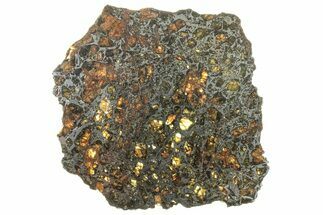2.22" Polished Gyarub Zangbo Pallasite Meteorite (21.1 g) Slice
This is a 2.22" wide (21.1 gram) sliced and polished piece of the unusual pallasite meteorite, Gyarub Zangbo.
It comes with an acrylic display case.
It comes with an acrylic display case.
The Gyarub Zangbo Pallasite
The Gyarub Zangbo pallasite meteorite was discovered in 2020 by Mr. G. Tulga while exploring the Qinghai-Tibet Plateau in the Qiangtang uninhabited area, NE of Gyarub Zangbo. Many disaggregated fragments composed of olivine and metal (kamecite and taenite) were found, as well as a much larger single metal-rich specimen nearby. Just over 17.6kg of this meteorite were recovered.
These meteorites are composed of dark brown olivine and metal in variable proportions from specimen to specimen.
Meteoritical Bulletin Database Entry - Gyarub Zangbo Pallasite
The Gyarub Zangbo pallasite meteorite was discovered in 2020 by Mr. G. Tulga while exploring the Qinghai-Tibet Plateau in the Qiangtang uninhabited area, NE of Gyarub Zangbo. Many disaggregated fragments composed of olivine and metal (kamecite and taenite) were found, as well as a much larger single metal-rich specimen nearby. Just over 17.6kg of this meteorite were recovered.
These meteorites are composed of dark brown olivine and metal in variable proportions from specimen to specimen.
Meteoritical Bulletin Database Entry - Gyarub Zangbo Pallasite
About Pallasites
Pallasite meteorites are a class of stony-iron meteorites. They were once believed to have originated at the core-mantle boundary of asteroids that shattered through impacts, but a recent hypothesis is that they are a mixture of core and mantle minerals.
Pallasite meteorites consist of olivine (peridot) crystals surrounded by iron-nickel matrix. Upon acid etching, some pallasites display interweaving structures known as Widmanstätten patterns (or Thomson lines) in the metallic matrix. These structures are iron-nickel alloy crystals, typically kamacite and taenite, that cooled over millions of years in the vacuum of space.
Pallasites are quite rare: only about 200 are known, and only four have had observed falls. This represents less than 0.2% of all classified meteorites!
Pallasite Care
Pallasites are even more susceptible than most iron meteorites to rusting and deterioration due to moisture in the atmosphere; proper care includes keeping them in moisture-free environments. This is particularly important in areas with high humidity, such as Florida. All pallasite material we sell has been stabilized in some way, which will help with this issue, but care still needs to be taken to keep your treasure in good condition. Keep pallasites stored in a moisture-free environment, preferably with a corrosion inhibitor such as silica gel beads or a dehumidifier.
Pallasite meteorites are a class of stony-iron meteorites. They were once believed to have originated at the core-mantle boundary of asteroids that shattered through impacts, but a recent hypothesis is that they are a mixture of core and mantle minerals.
Pallasite meteorites consist of olivine (peridot) crystals surrounded by iron-nickel matrix. Upon acid etching, some pallasites display interweaving structures known as Widmanstätten patterns (or Thomson lines) in the metallic matrix. These structures are iron-nickel alloy crystals, typically kamacite and taenite, that cooled over millions of years in the vacuum of space.
Pallasites are quite rare: only about 200 are known, and only four have had observed falls. This represents less than 0.2% of all classified meteorites!
Pallasite Care
Pallasites are even more susceptible than most iron meteorites to rusting and deterioration due to moisture in the atmosphere; proper care includes keeping them in moisture-free environments. This is particularly important in areas with high humidity, such as Florida. All pallasite material we sell has been stabilized in some way, which will help with this issue, but care still needs to be taken to keep your treasure in good condition. Keep pallasites stored in a moisture-free environment, preferably with a corrosion inhibitor such as silica gel beads or a dehumidifier.
$1,315
TYPE
Pallasite
AGE
LOCATION
Xizang, China
SIZE
2.22 x 1.73 x .06" thick, Weight: 21.1 grams
CATEGORY
SUB CATEGORY
ITEM
#301045
 Reviews
Reviews










